EXERCISE SHORTCUTS
Lunge Decompression | Hip Hugger to Platter Hands | Supine Decompression | Internal Leg Trace | Kneeling Founder | Anchored Back Extension
As the literal backbone of the body, the spine is a foundational part of movement: Its overall health affects athletic performance and how you move through daily life. Unfortunately, many people have been led to believe that this central piece of anatomy will inevitably wear out, leaving them with pain, immobility, and no options but surgery.
“Human beings generally don’t pay much attention to their spine until it hurts,” says adaptive yoga teacher Matthew Sanford, author of Waking: A Memoir of Trauma and Transcendence. “By that time, it’s not necessarily too late [to fix it], but learning about your body through pain is not the best way to live life.”
There’s a better approach: By caring for your spine today, you may be able to prevent many symptoms commonly associated with aging. And even if you’re already coping with issues such as chronic neck and back pain, osteoporosis, degenerative-disc disease, scoliosis, or kyphosis, chances are there’s still plenty you can do to ward off further damage and discomfort.
By maintaining mobility of the joints, proper alignment of the vertebrae, and strength in the musculature and connective tissues of your back, you can prevent and rehab many conditions we consider chronic and lifelong.
What’s more, developing a strong, mobile back may help you avoid acute injury in your workouts and daily life anytime you need to twist, lift, or bend.
Our experts break down the spine’s function, common issues that may occur, and strategies that can help keep your spine healthy.
How It All Stacks Up
Understanding the spine begins with understanding its complex structure.
It consists of around 24 small, movable vertebrae stacked on top of each other, along with the sacrum and coccyx. (Humans are born with 33 vertebrae; some fuse together as we age.) In between the vertebrae are shock-absorbing discs that prevent the bones from rubbing together. Everything is connected by a series of ligaments and tendons and supported by small muscles.
Together, this structure not only keeps you upright but also plays the all-important role of protecting your spinal cord — a column of nerves that links your brain with the rest of your body. The spine itself is connected to the ribs and pelvis and, therefore, to the arms, the legs, and the head.
When one link in this kinetic chain malfunctions, it creates a domino effect on neighboring segments and associated joints.
“The spinal column is one of the most important aspects of the human kinetic chain. It is paramount in dictating proper musculoskeletal function and general health,” says David Lipetz, MSPT, a physical therapist at LifeClinic Chiropractic and Rehabilitation in Syosset, N.Y.
When one link in this kinetic chain malfunctions, it creates a domino effect on neighboring segments and associated joints.
There are many things that can push this kinetic chain out of whack, including moving too infrequently, exercising with poor form, and suffering an acute injury. Hormonal changes — namely, flagging estrogen and testosterone levels later in life — can also affect spinal health by lowering bone density.
In addition, regularly sitting or standing with poor posture can lead to discomfort throughout the kinetic chain. “If your head is out in front of your torso all day [while you’re] sitting at a computer or staring at your phone, you’re going to be pulling your whole spine out of alignment,” explains Lynn Shuck, a Minneapolis-based Eischens-yoga teacher. You may feel the strain in your neck, upper back, lower back, or any combination thereof.
Lifting heavy weights can create problems if you try to recruit your spine instead of your hips, says Eric Goodman, DC, creator of Foundation Training, a program designed to mitigate acute and chronic back pain. (Goodman notes that when performed correctly, moves like deadlifts are actually an excellent option for a healthy back. For tips on form, visit “BREAK IT DOWN: The Deadlift“.)
Even your mental outlook can affect the health of your spine, especially if you suffer from chronic back pain.
Even your mental outlook can affect the health of your spine, especially if you suffer from chronic back pain. Although discomfort often starts from a physical place (such as an acute injury), it typically persists because of your brain.
“We want to see the spine itself as more than just part of the skeleton,” Shuck says, because its health can affect the health of every other part of your body, including the mind.
Although it may seem like there are many factors working against spinal health and resilience, there’s still a lot we can do to turn the tide in our favor. These expert-backed strategies can help you keep your spine healthy for the long haul.
Exercise for strength and mobility.
The incredible structure we know as the spine is capable of more healthy movement patterns than we may think. Regularly moving in these many directions can keep it — and the rest of your body — healthy.
The spine can flex (bend) and extend (straighten) forward and backward, as well as bend to either side, and twist. You can also create space between the vertebrae: Sitting or standing, straighten up through your torso and imagine reaching your tailbone down to the ground while lifting the crown of your head toward the sky. This elongation can create space along the whole spine, Shuck says.
Resistance training that strengthens the muscles and tissues surrounding the spine, along with mobility exercises that integrate the joints and bones, are key as well. “Proper movement and alignment of all the spinal joints sets the foundation for proper neuromuscular communication, allowing the brain and body to work in harmony,” Lipetz says.
Yet it’s not enough to lift weights and practice mobility exercises a few times a week. To keep your spine healthy, it’s important to keep moving.
“Even people who are considered very active sit for long periods at a desk job,” Shuck notes. “Then they go do a heavy workout for an hour, but there’s still 23 hours left in the day. That’s not moving.”
If you work at a desk, stand up every 30 minutes and perform gentle movements: Twist, lean from side to side, bend forward and backward, lift your arms overhead, and place your arms in a doorway and lean forward to get a chest and shoulder stretch (see “The Desk-Dweller’s Repair Plan” for more movement ideas). Or, if you usually sit on the couch to watch TV, try moving to an ottoman.
Better yet, sit on the floor. By sitting without back support on the floor or something closer to it, “what you’ll discover is that you move a little more,” Shuck says. “Each time you shift your legs to the other side, or cross them differently, or lean onto your hand, you’re putting weight on another joint in another way and you’re using your muscles differently to support your spine.”
On the floor, sit on a pillow or bolster for added support and to help maintain an upright posture.
All those little movements may not seem like much, but they add up.
Hydrate well — and nourish with key nutrients.
Keeping an eye on your hydration is a simple way to improve both your spinal health and your overall well-being. “Hydration is one of the cheapest ways people can get themselves feeling better,” Goodman says. “If you’re even slightly chronically dehydrated, adding a liter or two of water a day will change how you feel exponentially.”
Up to 60 percent of the human body consists of water. The amount of water you consume affects everything, including muscles, organs, and tiny cells — as well as the spongy discs that separate the vertebrae.
If you’re even slightly chronically dehydrated, adding a liter or two of water a day will change how you feel exponentially.”
“Assuming we are well hydrated, our discs will successfully rehydrate themselves at night after performing as a shock absorber and spacer throughout the day,” Lipetz explains. “If we do not have enough water in our body, this can contribute to poorly hydrated discs, leading to a collapse of disc height and creating potential lower back pain and sciatica.”
In addition to staying hydrated throughout the day, eating plenty of whole-food proteins, vegetables, and fruits can help keep the bones in your spine strong as you age.
Many nutrients contribute to bone health, but pay particular attention to calcium, magnesium, phosphorus, and vitamin D. A blood test can tell you where your nutrient levels stand and whether they’re optimal for your age, sex, and activity level. Then you can modify your diet or add supplements, if necessary.
Build awareness.
Developing the mind–body connection can be a powerful way to support and improve function in any area of the body. Because of the sensory and neurological functions of the spine, building awareness can be particularly impactful — not just for the back, but for the entire body.
“The spine is the organ of connection: It’s what connects you directly to what’s around you,” Sanford says. You receive sensory information in your brain, which organizes and makes sense of everything, but your spine is the core channel through which this vital information travels. “If it’s coming through the body, it’s coming through the spine.”
Paying attention to our spinal function lowers the risk of developing discomfort throughout the rest of the body, he adds. “Refining and clarifying spinal awareness helps ensure that our life force flows more fluidly and gracefully to the outer edges of our bodies. This can help decrease pain and lessen the impact of injury over time.
“There’s a lot of space that’s worth exploring between being completely oblivious of your spine and having to get back surgery,” Sanford says.
“There’s a lot of space that’s worth exploring between being completely oblivious of your spine and having to get back surgery,” Sanford says.
You can also build spinal awareness into your everyday activities by simply pausing from time to time to focus on your posture, Sanford explains. If you’re seated at your desk, think about sitting up straight and tall so you can feel each sit bone connected to your chair and your inner heels connected to the floor. Take a couple of breaths so you feel your rib cage expand.
Or take a moment to lie flat on your back and spread-eagle your arms and legs. Allow your body to relax, and notice what you feel. (If this is tough on your lower back, place a folded blanket or yoga mat in the space between your back and the floor to add support.)
“Usually, we have to work to move against gravity, so sometimes it’s cool to use the support of gravity on your spine,” Sanford says.
What’s more, bolstering the spine has a calming effect on the nervous system, he explains. You likely know the saying, “I’ve got your back”: Simply placing a hand between someone’s shoulder blades can make them feel calm and safe. You can offer yourself the same support with a pillow, bolster, or blanket.
Explore noninvasive treatments.
Consider adding tools like a foam roller or percussion-therapy device to your at-home healthy-spine program. (But be cautious of home spinal-traction devices, which promise to relieve pressure on the spine, says Lipetz. He recommends leaving this treatment modality to a professional.)
Chiropractors and physical therapists are invaluable resources on spine health — before any issues crop up. “Just like you go to your doctor or dentist for checkups, we’re able to detect abnormalities before they become a problem,” Lipetz says.
A physical therapist or chiropractor can sit down with you to discuss your concerns, perform spinal adjustments or soft-tissue massage, and recommend specific exercises or stretches you can practice at home to prevent problems from cropping up later.
Seek professional support for pain.
Visit a medical professional if you experience sharp pain, new pain, or worsening pain in your back. Brushing it off or trying to fix it yourself may only make the pain worse.
You don’t want to shoot from the hip with exercises. You’re basically trying to understand something that’s really complex and often takes a lifetime to master.”
“You don’t want to shoot from the hip with exercises,” Goodman says. “You’re basically trying to understand something that’s really complex and often takes a lifetime to master.”
6 Exercises for a Healthy Spine
Regular movement is key for spinal health, but prioritizing specific exercises can help ensure that you do the right types of movement. “The best form of exercise is body-weight control and strength,” Eric Goodman, DC, says. “You can move into any other movement or resistance you’d like once you master your own body weight to the best of your ability first.”
He suggests the following exercises to help you control your body so you keep your spine aligned in any range of motion. You can take what you learn from these exercises to make your strength training and cardio workouts safer and more effective.
“If you’re not doing the act of alignment first, you’re likely going to [have to] correct injuries at some point,” he explains. “If you do that alignment from the get-go, you’ll be in a preventive place the entire time you’re getting stronger.”
For all the exercises, practice what Goodman calls “decompression breathing”: With each inhale, breathe deeply into your rib cage to actively lift and widen it in all directions. Visualize your vertebrae extending away from each other as you lengthen your spine. With each exhale, aim to maintain this feeling of vertebral separation.
Consult a physical therapist about targeted treatment if you have moderate back pain that doesn’t improve after two weeks. If you have already been diagnosed with an underlying spine condition, continue working with your healthcare provider before attempting these exercises.
Similarly, if back pain prevents walking or causes pain at night, see a medical professional before doing these exercises.
Lunge Decompression

- Begin in a split stance with your legs stride length apart (or slightly farther).
- Point both feet forward and lift your back heel a few inches off the floor.
- Distribute your weight evenly between your front and back leg and pull your front heel and back toes toward each other.
- Expand your ribcage; think about elevating your ribs away from your hips.
- Engage your abdomen.
- Pull your chin back, breathe your chest up, and lengthen the back of your neck.
- Scoop your arms overhead, keeping them in front of your ears.
- Keep your weight evenly distributed between your front and back legs.
- Hold the pose for 45 to 60 seconds or approximately five to 10 deep breaths.
- Switch legs and repeat.
Hip Hugger to Platter Hands
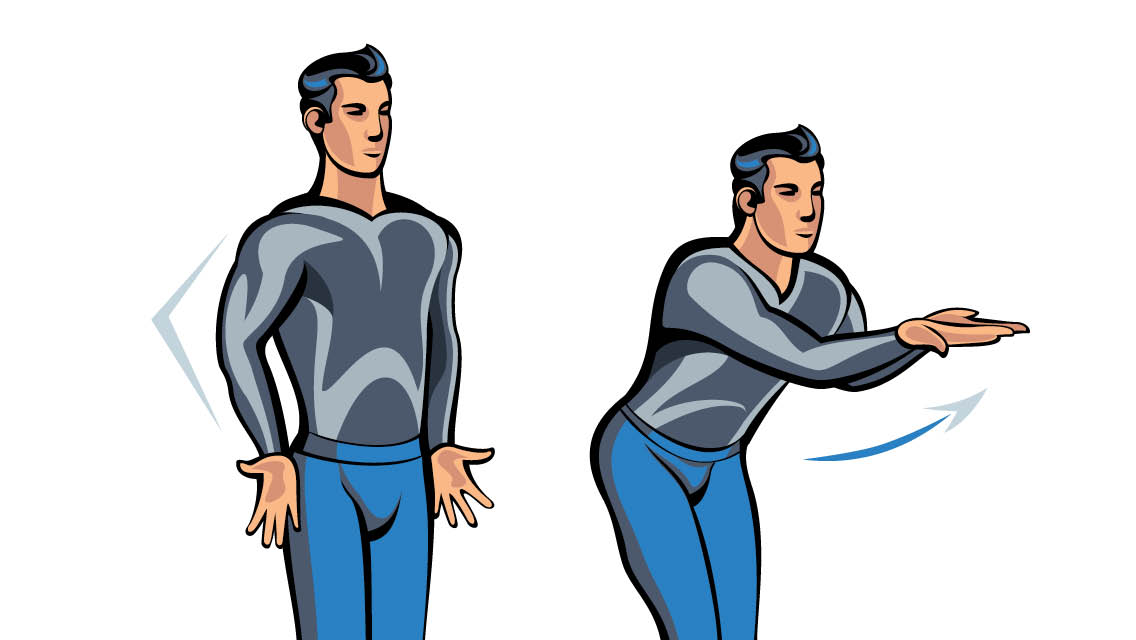
Hip hugger:
- Stand tall and let your arms hang at your sides, palms facing forward.
- Press the pinkie side of each hand against the sides of your thighs.
- Keeping your hands pressed against your thighs, pull your elbows back. Spread your hands and rotate the thumbs back.
- Hold the pose for 45 to 60 seconds or approximately five to 10 deep breaths.
Platter hands:
- From hip hugger, bend your elbows to 90 degrees so your forearms touch your sides.
- Extend your forearms forward so the sides of your hands come together in front of your chest, palms open and thumbs pulling away from one another.
- Hold the pose for 45 to 60 seconds, or approximately five to 10 deep breaths.
Supine Decompression
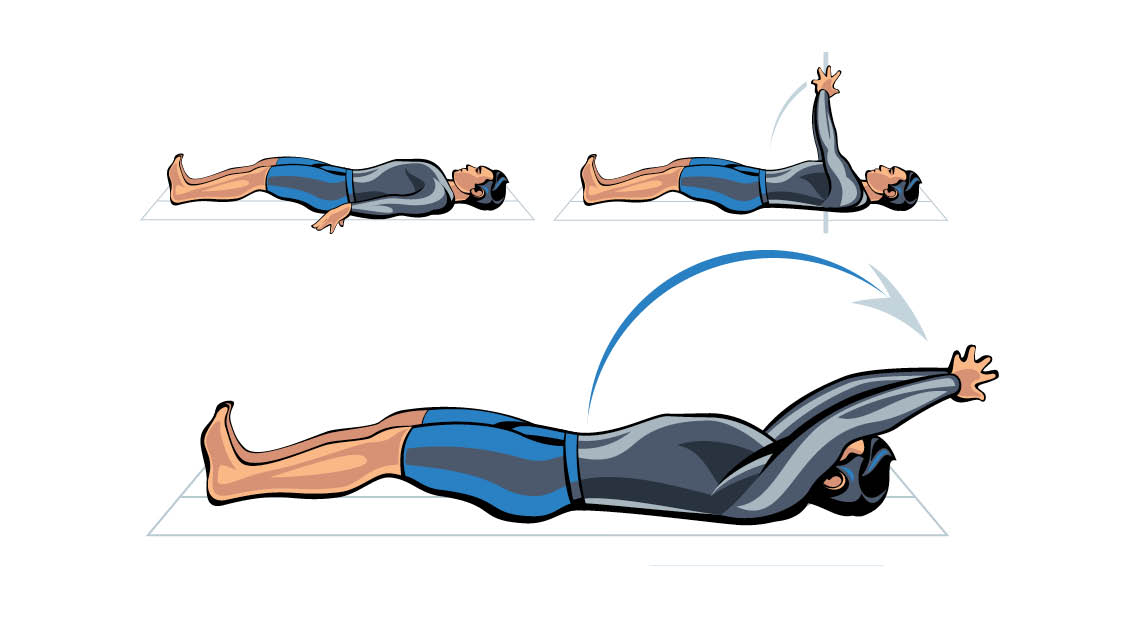
- Lie on your back with your legs long, big toes touching, and heels slightly apart.
- Flex your feet so your toes point up, and squeeze your inner thighs together.
- Expand your ribcage; think about elevating your ribs away from your hips.
- Engage your abdomen.
- Scoop your arms overhead and back, keeping your arms in front of your ears.
- Expand the back of your ribcage by reaching it toward the floor and away from your hips.
- Hold the pose for 45 to 60 seconds or approximately five to 10 deep breaths.
Internal Leg Trace
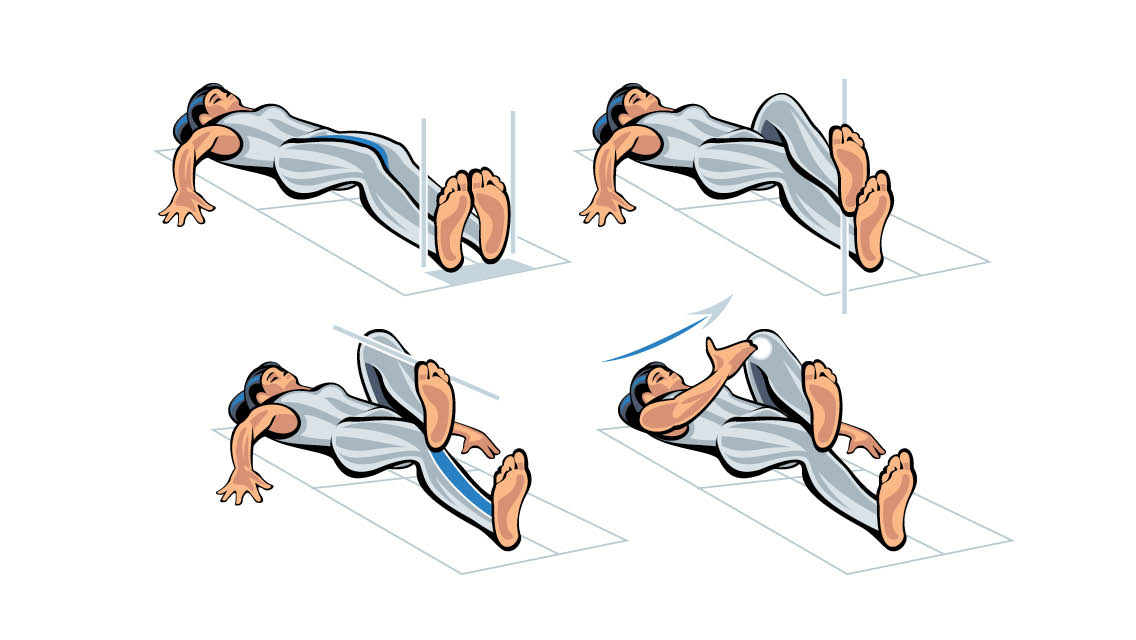
- Lie on your back with your legs long, big toes touching, and heels slightly apart.
- Flex your feet so your toes point up, and squeeze your inner thighs together.
- Place one heel on top of your opposite ankle and rotate your top hip to bring your knee and toes across the midline of your body.
- Keep your pelvis stable.
- Trace the top heel up your bottom leg, stopping just below or just above your kneecap.
- Bring the inside of your hand to meet the inside of your top leg.
- Press into your top leg, applying roughly five to 10 pounds of pressure.
- Hold the pose for 45 to 60 seconds or approximately five to 10 deep breaths.
- Switch legs and repeat.
Kneeling Founder
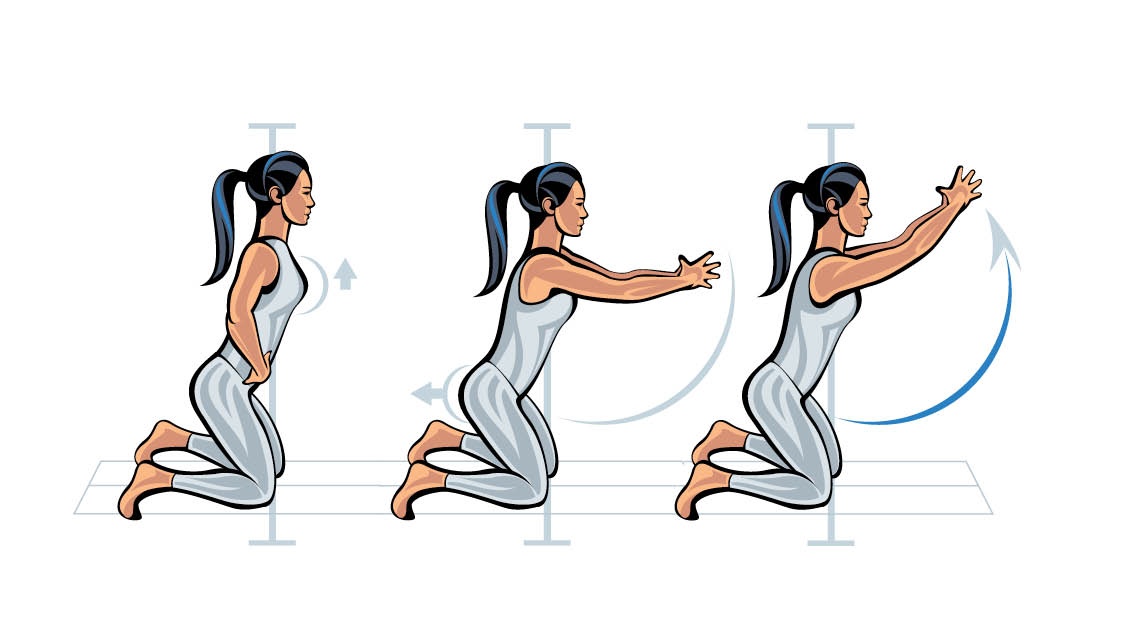
- Kneel on the ground with knees hip width apart and feet slightly wider.
- Flex your feet so your toes press into the floor.
- Hinge your hips back, keeping your weight over your knees, chin back, and chest up.
- Scoop your arms in front of your chest, fingertips touching. Try to push your hips even farther back.
- With your fingertips still touching, lift your arms overhead.
- Keep your arms in front of your ears, your chest lifted, and your chin back.
- Hold the pose for 45 to 60 seconds or approximately five to 10 deep breaths.
Anchored Back Extension

- Lie on your stomach with your legs long.
- Flex your feet so your toes press into the floor. Bring your big toes together, heels slightly apart.
- Bend your elbows into your sides and let your palms rest on the floor beside your head.
- Keeping your neck neutral, lift your head a few inches off the floor.
- Rotate your thighs inward.
- Lift hands, wrists, and elbows off the floor.
- Inhale and expand your ribcage. Aim to elevate your ribcage away from your hips.
- Continue to engage your abdomen on the exhale to maintain body length and elevation.
- Hold the pose for 45 to 60 seconds or approximately five to 10 deep breaths.
This article originally appeared as “Back On Track” in the January/February 2022 issue of Experience Life.


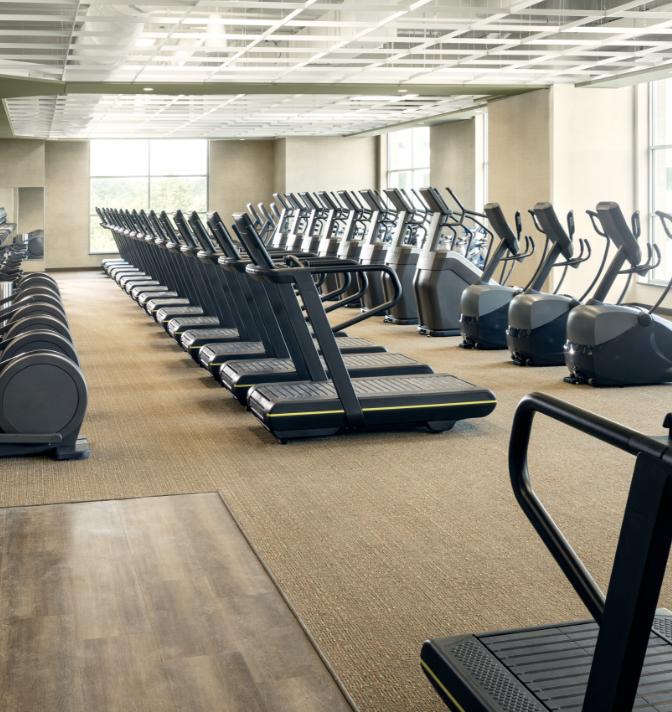
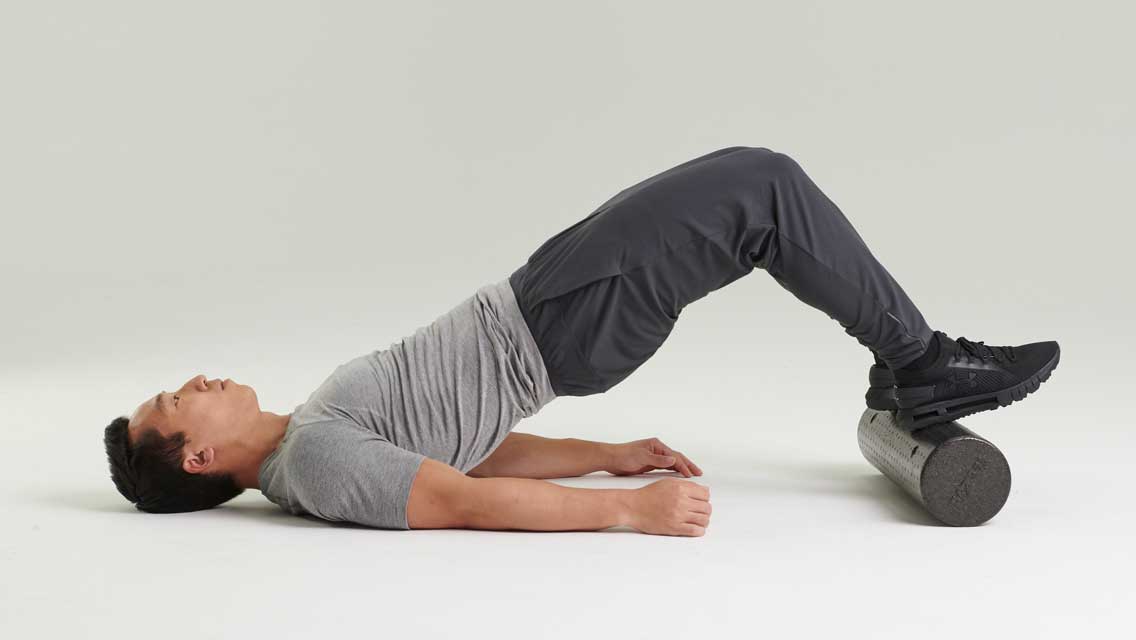
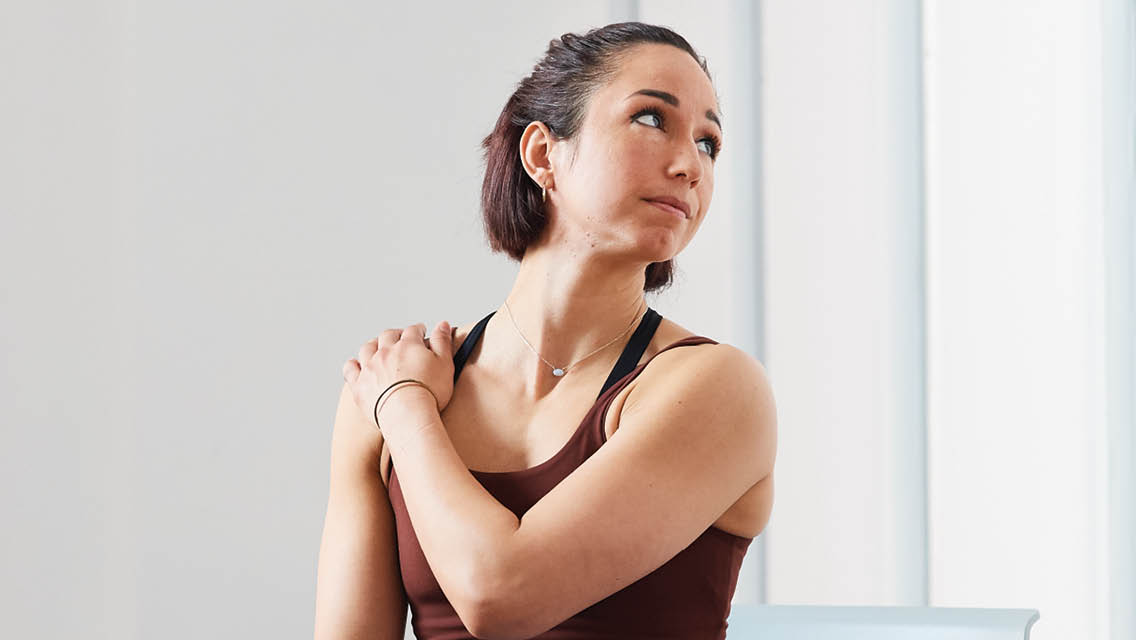

This Post Has One Comment
Great spine article, thank you. Perfect timing as I have had abdominal/breast surgery and need to rebuild and straighten my spine.
Great work, happy new year, and thanks very much!
Erin